Bur Oak (Quercus macrocarpa) is a large, deciduous tree belonging to the Fagaceae family and the macrocarpa species. Native to North America, this woody plant is a versatile native tree, known for its impressive size, often growing over 46 meters tall. Its acorns, the largest among all oak species, are a distinctive feature.
The bur oak is commonly planted for its shade, making it a popular choice in landscapes, shelterbelts, and as an ornamental tree. With its sturdy structure and adaptability, it serves as a valuable addition to native planting projects and provides ecological benefits to its surroundings.
| Common name | Bur Oak |
| Botanical name | Quercus macrocarpa |
| Family | Fagaceae |
| Species | macrocarpa |
| Origin | North America |
| Life cycle | Woody |
| Plant type | Native Plant |
| Hardiness zone | 3, 4, 5, 6, 7, 8 |
| Sunlight | Full Sun |
| Maintenance | Medium |
| Soil condition | Clay |
| Soil ph | Acid |
| Drainage | Well-Drained |
| Growth rate | Medium |
| Harvest time | Fall |
| Flowering period | Spring |
| Height | 7- 80 ft. |
| Flower color | Gold, Yellow |
| Leaf color | Gray, Silver |
| Fruit color | Brown, Copper |
| Stem color | Brown, Copper |
| Fruit type | Nut |
| Fruit benefit | Showy |
| Garden style | Butterfly Garden |
| Uses | Lawn |
I. Appearance and Characteristics
Quercus macrocarpa, the bur oak or burr oak, is a species of oak tree native to eastern North America. It is in the white oak section, Quercus sect. Quercus, and is also called mossycup oak, mossycup white oak, blue oak, or scrub oak. The acorns are the largest of any North American oak (thus the species name macrocarpa, from Ancient Greek μακρός makrós “large” and καρπός karpós “fruit”), and are important food for wildlife.
Quercus macrocarpa is a large deciduous tree growing up to 30 metres (98 feet), rarely 50 m (160 ft), in height, and is one of the most massive oaks with a trunk diameter of up to 3 m (10 ft). It is one of the slowest-growing oaks, with a growth rate of 30 centimetres (12 in) per year when young.
However, one source states that a well-established tree can grow up to 51 cm (20 in) per year. A 20-year-old tree will be about 18 m (60 ft) tall if grown in full sun. Naturally occurring saplings in forests will typically be older. Bur oaks commonly get to be 200 to 300 years old, and may live up to 400 years. The bark is gray with distinct vertical ridges.
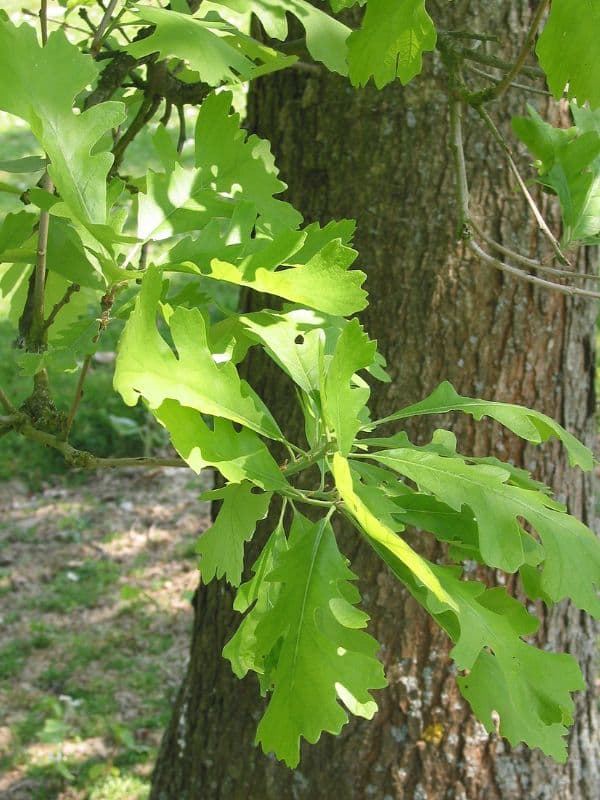
The leaves are 7–15 cm (2+3⁄4–6 in) long and 5–13 cm (2–5 in) broad, variable in shape, with a lobed margin. Most often, the basal two-thirds is narrower and deeply lobed, while the apical third is wider and has shallow lobes or large teeth. They usually do not show strong fall color, although fine golden hues are occasionally seen. The flowers are greenish-yellow catkins, produced in the spring.
The acorns are very large, 2.5–5 cm (1–2 in) long and 2–4 cm (3⁄4–1+1⁄2 in) broad, having a large cup that wraps much of the way around the nut, with large overlapping scales and often a fringe at the edge of the cup.
The wood when sawn transversely shows the characteristic annual rings formed by secondary thickening.
Bur oak is sometimes confused with other members of the white oak section, such as Quercus bicolor (swamp white oak), Quercus lyrata (overcup oak), and Quercus alba (white oak). It hybridized with several other species of oaks.
Bur oaks primarily grow in a temperate climate on the western oak–hickory forested regions in the United States and into Canada. It commonly grows in the open, away from dense forest canopy. For this reason, it is an important tree on the eastern prairies, often found near waterways in otherwise more forested areas, where there is a break in the canopy.
It is drought resistant, possibly because of its long taproot. At the end of the growing season, a one-year sapling may have a taproot 1.37 m (4+1⁄2 ft) deep and a lateral root spread of 76 cm (2+1⁄2 ft). The West Virginia state champion bur oak has a trunk diameter of almost 3 m (10 ft).
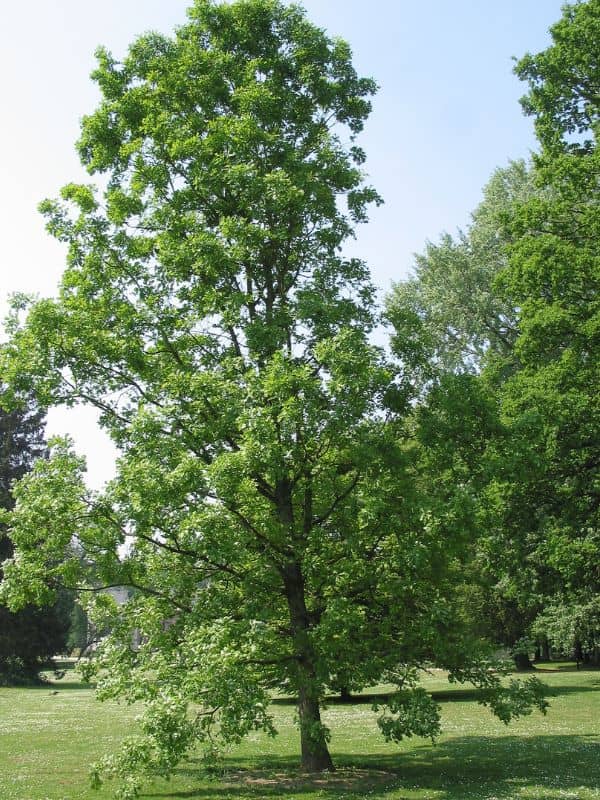
Large bur oaks, older than 12 years, are fire-tolerant because of their thick bark. One of the bur oak’s most common habitats, especially in Midwestern United States, is the oak savanna, where fires often occurred in early spring or late fall. Without fires, bur oak is often succeeded by other tree and shrub species that are more shade-tolerant.
Older bur oaks may survive in dense woodlands for 80 years, until they are weakened by wood-rot fungi in the lower branches killed by shade, and by 100 to 110 years, they are often snapped by wind storms.
II. Types of White Oak Trees
A bur oak’s native habitat is moist woodlands, bottomland forests, prairies, and sandhills. Bur oaks (Quercus macrocarpa) are a member of the white oak group of trees. Bur oaks share the same characteristics as other white oaks, including rounded lobes on the leaves and producing acorns (fruits) that mature in a single season and sprout soon after they fall in autumn.
Other white oak trees include:
- White oak (Quercus alba): Grows 60-100 ft. tall; 50-90 ft. wide
- Chinkapin oak (Quercus muehlenbergii): Grows 50 to 80 ft. tall; 50 to 70 ft. wide
- Swamp white (Quercus bicolor): Grows 50 to 70 ft. tall, 50 to 70 ft. wide
- Post oak (Quercus stellata): Grows 40 to 50 ft.; 35 to 50 ft. wide
III. How to Grow and Care
Sunlight
Bur oak prefers full sun with at least six hours of direct light.
Temperature and Humidity
Bur oak is well-adapted to the continental climate of its native range with its humid summers and subzero winters. The tree can be found as far north as Nova Scotia and down to Texas. It is one of the most cold-tolerant oak species.
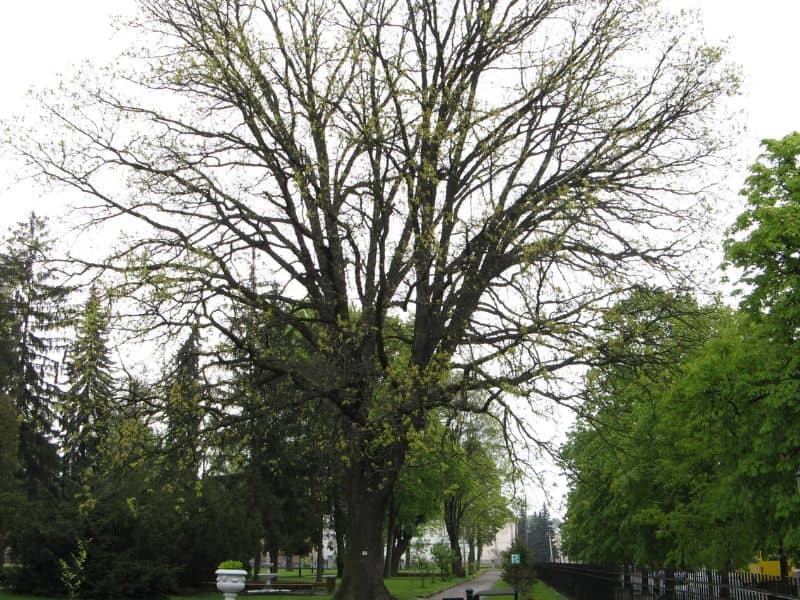
Watering
Bur oak has average water requirements but is especially thirsty during its initial growth phase, so it needs to be watered frequently in its first year. Keep the surrounding soil moist. When mature the tree can survive moderate drought but should be watered whenever natural rainfall decreases.
Soil
The tree can adapt to many different soils in terms of texture and structure. It grows in sand, silt, and clay and can withstand compacted soils and poor drainage.
Occasional flooding of the planting site is not a problem. However, the tree won’t do well when there is repeated and extended flooding, especially during the growing season.
Fertilizing
Bur oak can be helped by the application of a slow-release granular fertilizer in spring that will help to feed it throughout the growing season. Nitrogen is one of the key nutrients that it requires, so a fertilizer with an N-P-K ratio of 12-4-8 or 12-6-6 would be the best product to use.
Pruning
Bur oak should be pruned in late fall or early spring. Start by removing dead, diseased, or damaged branches at the base or where they meet a lateral branch. Cut off any branches that grow downward or those that are rubbing together. You can prune out up to 1/3 of the branches in a season to open the canopy and allow better sunlight and air circulation.
Propagation
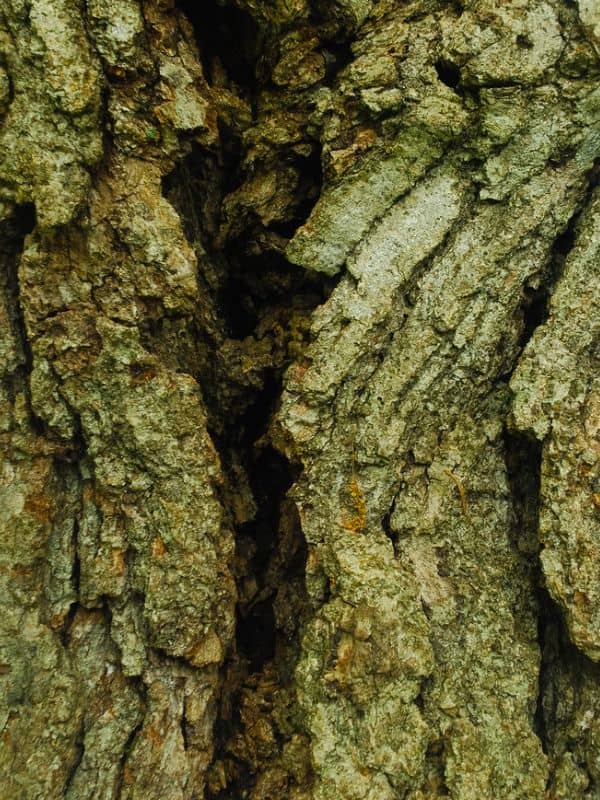
While growing an oak from acorns is the most common route, you can also propagate bur oak from cuttings. Here’s how:
- With sharp, clean pruners, take several cuttings from hardwood, each at least 6 inches long, from stems at least the diameter of a pencil. The cutting should have at least three or four nodes.
- Snip the leaves off the bottom, leaving only a few at the top. Make a fresh, sharp cut at a 45-degree angle on the bottom of the cutting,
- Dip the cut end in rooting hormone and plant it in a container filled with potting soil made of peat moss and perlite.
- Keep the soil moist and the humidity high by wrapping a clear plastic bag loosely over the cutting. Place it in a warm area until roots form, which might take two or three months. Keep in mind that not all cuttings will “take” and grow—don’t be disappointed if you lose several of them.
- Once roots grow, put the tree indoors in a sunny, warm spot for the first year. Then, it is ready to be transplanted into the ground.
How to Grow From Seed
If you don’t mind tending to it for a few years before the seedling is large enough to be transplanted, you can grow bur oaks from acorns. Inspect the acorns for cracks and holes and choose only fully intact ones. To grow seedlings, follow these steps.
- Soak them in water for 24 hours, which helps you identify hollow ones that float on top. These should be discarded. Remove the caps if they haven’t fallen off on their own yet.
- Fill a 1-gallon planting container with a drain hole with the same soil as the location where you intend to plant the tree. Mix in about one to two trowels full of organic matter or compost.
- Place two to three soaked viable acorns in the container, laying them on their sides. Cover with 1 to 2 inches of soil.
- Water regularly and deeply. The acorns will start to sprout in about one month.
- Once the seedlings emerge, only keep the strongest one and gently pull out the others with their acorn. Protect the young roots from root burn by shielding the exterior of the container from the sun, either with wood, heavy fabric, or a second, larger pot.
Potting and Repotting
When starting a bur oak from an acorn, use a 1-gallon container with good drainage. The container might seem much too large at first, but remember that bur oaks are finicky to transplant because of their taproot. You want to avoid transplanting the seedling to a larger pot when it outgrows the original one.
Overwintering
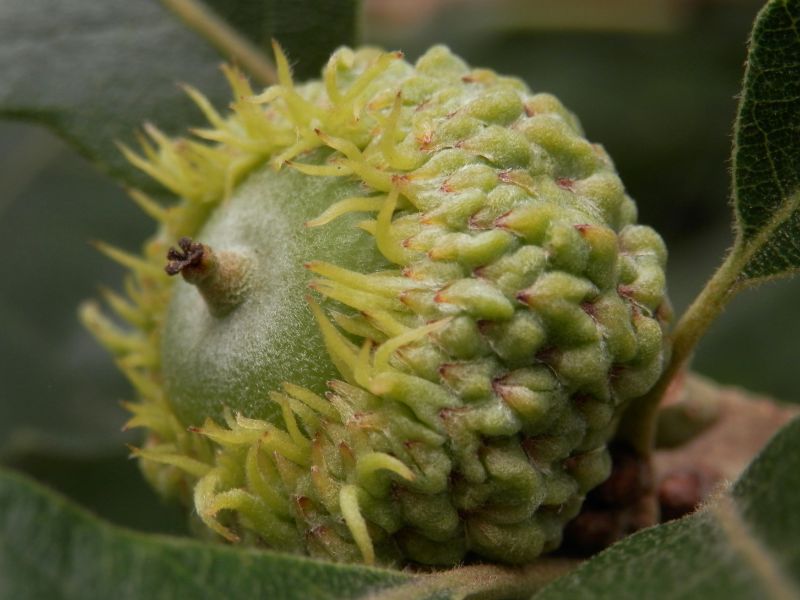
These very cold-hardy trees can tolerate freezing temperatures in their usual growing zones. Young trees still in containers or newly planted can benefit from a layer of mulch or straw over the roots.
Pests and Diseases
Common Pests and Plant Diseases
The bur oak is affected by the same pests and diseases common among oak trees in the Northern Hemisphere. Some of these include oak-leaf blisters, which look like small white blisters on the leaves in midsummer, and leaf spot, which creates small black or brown spots on the leaves.
Bur oak blight is a fungal leaf disease that causes leaf browning and leaf loss in late summer and early fall, only affecting the small-acorn variety of bur oak. These three fungal diseases can be treated with a fungicide.
A white-rot fungal disease, sometimes known as canker, can affect the trees as well—and in this case, there isn’t much you can do. Removing the tree before the fungus affects other plants nearby is the best treatment.
Various pests make their home in bur oaks, such as caterpillars, oakworms, and scale. Introducing ladybugs into the landscape can help control the issue, as can removing caterpillars by hand. Using an insecticide is a last-ditch effort but often works, especially for immature trees.
Common Problems
Bur oak trees are easy to grow in many soils, withstanding temperature swings and adverse conditions.
Growths on Bur Oak
Oak trees quite commonly develop lichen, which appears as a gray or green growth on a tree’s trunk or larger branches. Lichen can develop at any point during its lifespan and is not a health indicator. Lichens don’t cause a problem and can be left alone.
Mistletoe is a parasitic plant that often attaches to oak trees. You can spot mistletoe because it remains green in the winter, long after the bur oak has dropped all its leaves. To control mistletoe, cut the affected limbs from the tree at least 1 or 2 feet below where the mistletoe is attached. Large infestations might require the use of chemicals designed to attack mistletoe.
Tree Isn’t Producing Acorns
It might not be old enough if your bur oak tree does not produce acorns. The bur oak is a slow-growing, long-lived tree that must be at least 35 years old before it has viable acorns.
III. Uses and Benefits
- Ornamental uses
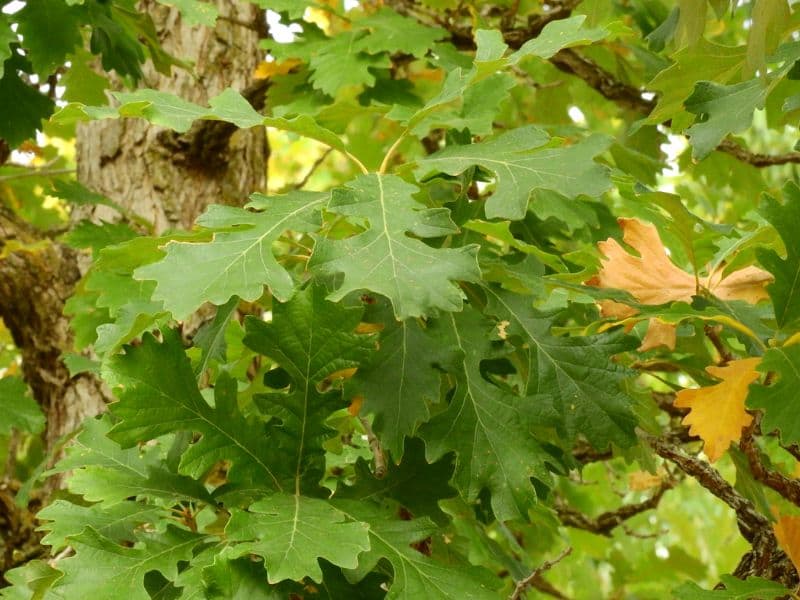
Bur oak truly is a mighty oak that grows to a towering height and spreads over a great area. You’ll need a large garden to grow this giant, and it is more commonly seen in parklands and open spaces. However, it is an attractive tree that attracts butterflies, birds, and mammals, and can be a rewarding specimen and shade tree for large lawns. Plants that grow well in the same conditions as this oak include rhododendrons, pine trees, and hardy ferns.
- Other uses
The wood of Quercus macrocarpa is commercially valuable; it is durable, used for flooring, fence posts, cabinets, and barrels. The acorns can be eaten boiled and raw. Native Americans have used the astringent bark to treat wounds, sores, rashes, and diarrhea.
Find Where to Buy the Best Bur Oak (Quercus macrocarpa)

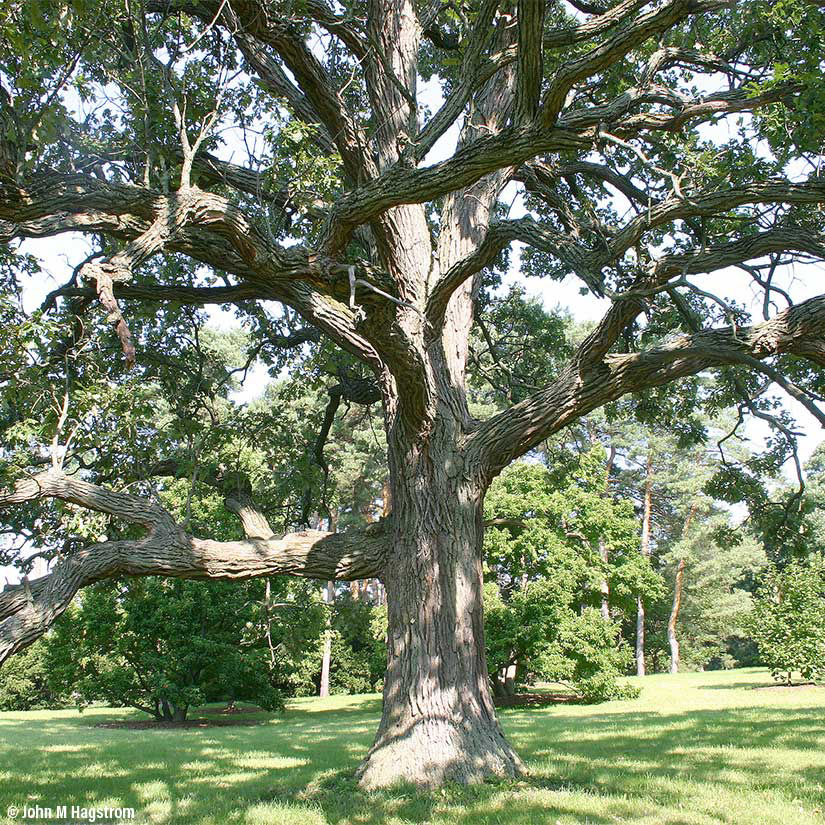







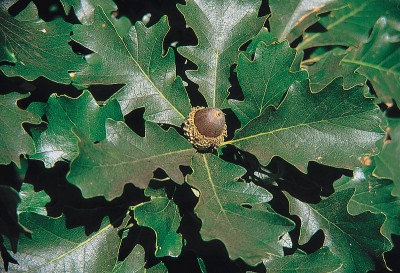








Leave a Reply